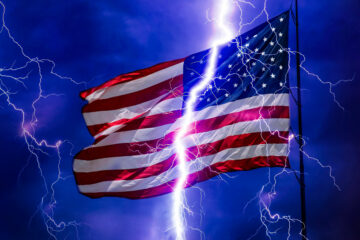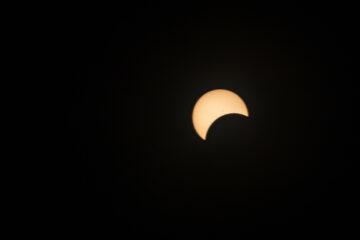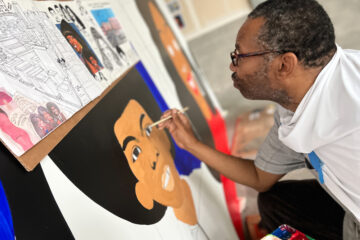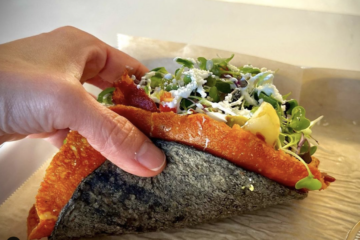From Supporting the Movement to Becoming it: The Death of Leonard Bradley Jr.
Guest Post by Meaghan Mitchell
Alongside fellow activists and allies, I actively protest to draw attention to systemic and institutionalized racism in America, especially as it relates to the disproportionate number of black people losing their lives at the hands of police (or racist idiots who think they are police) nationwide.
Unfortunately, this level of activism is nothing new for me.
In 2009, I marched for Oscar Grant.
In 2012, I attended a candlelight vigil for Trayvon Martin.
In 2013, I attended my first Black Lives Matter protest.
In 2014, I protested for Alex Nieto.
In 2016, I marched for Mario Woods.
On June 9th, with Mayor London Breed, Supervisor Shamann Walton, activist Phelicia Jones, and fellow activists – including my 69-year-old mother – I knelt on the steps of San Francisco’s City Hall for 8 minutes and 46 seconds for George Floyd.
I march because I consider my black skin a badge of honor and because black lives matter.
A few weeks ago, I participated in a youth solidarity march in the Bayview District organized by students from Academy X and Ruth Asawa School of the Arts (SOTA). Hundreds of us assembled at the Bayview Opera House, took to 3rd Street and marched to Mission Bay’s police station. As we arrived at the station, everyone began chanting: “Justice for Leonard Bradley Jr.! Justice for Leonard Bradley Jr.!”
My heart sank, and I became emotional. Leonard was the baby brother of my childhood friend, LynTise Bradley (now Jones), who was murdered by two officers representing the San Pablo Police Department.
I grew up in the Bayview District with LynTise and always admired her. She is intelligent, gifted, and the type of friend that stands up for you with no questions asked. Her heart is big and pure. Her eyes light up when she laughs. Her strength and ability to face life’s obstacles make her a leader in the San Francisco community.
LynTise is no stranger to trauma. When she was 6-years-old, her family hosted a neighborhood Halloween party. After hours of hanging out, LynTise fell asleep during the party. Her older cousin picked her up and took her to her bedroom upstairs. She placed LynTise on her bed with her head facing the foot of the bed.
Not long after, an unrelated incident took place in the neighborhood that escalated to a shootout. A stray bullet entered LynTise’s bedroom window and hit her in the leg. “That’s the significant part of this story,” LynTise noted. “My cousin laid me down the opposite direction of how I normally lay. If I had put myself to bed, I would have gotten shot in the head. The bullet hit the top of my bed.”
From that point at such a young age, LynTise knew there was a divine plan for her. “I’m here to tell this story, and it’s hard. You wonder why you have to encounter all these things, especially gun violence. In many ways, you are an unwilling participant. Still, all of a sudden, you are thrust in the middle of a revolution and war. But I knew that this story would eventually have significance and how it correlates to other life events.”
As LynTise grew up, she was met with other challenges. With a father who abused drugs and a mother who was incarcerated, she learned to fend for herself at 15 years old and support her three younger brothers. While trauma continued to knock on her door without invitation, LynTise found solace in participating in extracurricular activities and after-school programs. Residents from Bayview often acted as surrogate mothers and fathers and supported her growth. “Even when I wanted to get out there and get it poppin’ and do something stupid, I had people say things like, ‘Hell naw, that ain’t even you Tee. Stay in school because you are not about to do this, said LynTise.'”
After graduating high school, LynTise went to FISK – a historically black college. With a sociology degree in hand, she traveled back to San Francisco’s Bayview District, where she focused on youth and community development. “My plan always was to come back to my community and support those who, like me, encountered a lot of obstacles and are just trying to find themselves,” LynTise added.
November 14th, 2009 everything changed. “I had an eerie feeling that day,” said LynTise. “It happened in a field near my mom’s house in San Pablo. On their way to my apartment in Richmond, my mom saw an ambulance and told my stepdad to turn around because she had a feeling my brother was in trouble, but my stepdad didn’t think Leonard was involved, so they continued driving.”
Hours went by, and nobody from the family heard a word from Leonard. “My cousin kept blowing up my phone,” LynTise said. “She told me that she had someone on the phone claiming to be Leonard’s girlfriend, but said she doesn’t want any part of this, and I was like, ‘No part of it? What do you mean?’ She said the police were chasing after Leonard, and she followed them,” LynTise continued. “She said, ‘He’s laying in the field and won’t get up.’ I immediately told my family that we had to go back to my mother’s in San Pablo. My mom broke out of my apartment, screaming: ‘He’s dead! I told you!’ My stepdad told her to calm down since we still weren’t sure. Everyone was in a panic.”
Once LynTise arrived at her mother’s house in San Pablo, her stepdad informed her that it was indeed Leonard who was shot. “I still didn’t believe it,” said LynTise. She drove to the field where the incident took place but was blocked by police officers, so she took an alternate route, which led to a hill overlooking the field. She looked down and saw her brother’s lifeless body laying on the ground. “I had to see it for myself, and I got the confirmation,” added LynTise.
According to the coroner’s report, Leonard was shot two times in the back and once each in his shoulder and elbow. However, the bullet that killed him was a point-blank shot to the head while he was at a lowered posture. That means he was shot while he was either falling or already on the ground. Leonard was unarmed.
Before the incident, Leonard was riding in a car with a friend. It turns out the car was stolen, and someone called in the plates. Once the police arrived, his friend jumped out of the car and fled the scene. In a panic, Leonard went behind the wheel and drove less than a mile away from the cops before exiting the car and running.
San Pablo officers Frank Perino and Kenneth White were the two cops who pursued and shot Leonard. Like many other police shootings, their reason was they “assumed he had a gun and feared for [their] lives.” They claimed that while chasing Leonard, the unarmed teenager stopped abruptly and allegedly reached at his midsection, which prompted them to shoot.
So, who was Leonard Bradley Jr.? He was a student, grandson, son, brother, uncle, cousin, and native San Franciscan. “He was also a super bright person who had a huge smile – quirky and charismatic,” said LynTise. “He was someone you couldn’t help but laugh when he came around,” she continued. “He always wanted everyone to be ok, feel loved and included,” she added. “He moved differently – had an angelic vibe – and brought warmth.”
Most importantly, Leonard was an innocent 16-year-old teenager with a bright future. Like most youth, he may not have chosen some of his friends wisely – but that kind of poor judgment doesn’t cost white kids their lives. The media characterized him as being gang-affiliated. They made it seem as if him being killed by cops made the streets safer when in reality, he was shot by two racist cops. Leonard Bradley Jr. was yet another unarmed black man – a child, really – killed by a gunshot fired into him while he was already in a lowered position.
Both officers were put on paid leave following the murder. Three years prior, Officer Frank Perino killed another unarmed black man and returned to work without any disciplinary action or real investigation. Five years later, Officer Kenneth White was arrested in San Francisco on charges involving trafficking heroin and cocaine. White was also charged for child endangerment as his two-year-old child was in the backseat of his car during the drug transaction.
“I know that activism has always been in my bloodline, but I never thought I would be sitting here directly impacted by police brutality,” LynTise told me with tears in her eyes. “You think about what level of racism you would be willing to take in to lessen the harm. It’s like, can I get a slap instead of a punch? Could I get a push instead of a gunshot? When you kill us, you leave us with nothing. One thing I know is that I would have taken that bullet a thousand times over my brother.”
Now married with two sons and a daughter, LynTise still struggles with the death of Leonard, but is also trying to communicate with her children about what it’s like to be black in America. “There are so many things I want to protect them from as a parent, but I know there will be times when they’ll have to walk through this world through their own black skin,” said LynTise. “I tell them that life will bring challenges and mommy and daddy won’t always be there when it happens, but if you can make it home we’ll get through it together whether that looks like activism, holding people accountable or wiping away tears. If I can’t do anything else, I can hold your hand.”
Leonard’s death wasn’t televised. You won’t find cell phone footage or a hashtag by his name. LynTise and her family have been doing the work to make sure that his name is not written out of history. They recently organized an event titled “Unified Black Mother’s Cry” at Lake Merritt to support women who have lost their sons and daughters who were taken too soon.
“It’s great when people march with you, and you can listen to tons of speeches, but none of these things will ever fill the hole of losing a loved one,” LynTise told me. “You have to be able to reconcile with all the pain in your heart. You really have to accept and process the fact they are not coming back, and the sooner you do that, I believe that is when the real healing comes,” she continued. “We get lost in the activism, but when you come home at night, and your head hits that pillow you are faced with that harsh reality, so what we did and will continue to do is create those spaces where we could scream and cry until our hearts are content in that moment.”
LynTise Jones, my childhood friend, went from supporting the movement to becoming the movement. I will never know what it’s like to be her, but one thing is for certain: As I continue to march for black lives, I will make sure my fellow protesters say his name: Leonard Bradley Jr!














